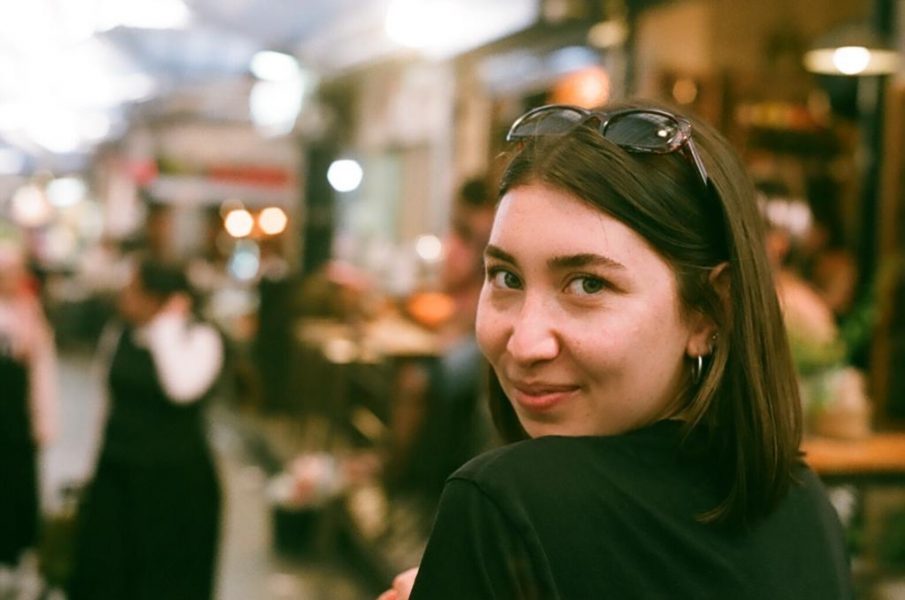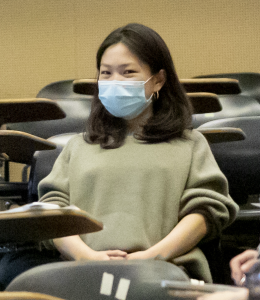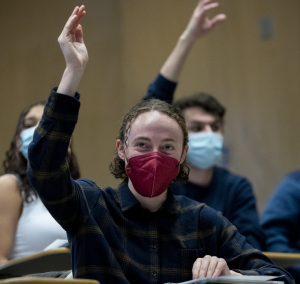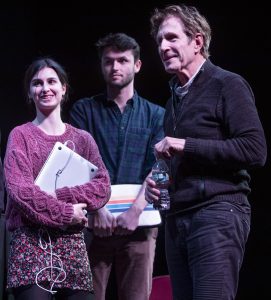By Clementine Callaway (BFF 2019; Bates Class of 2020)
Having the opportunity to serve as one of the directors of the 2019 Bates Film Festival was a wonderful privilege that I would not trade for the world. As someone who comes from a family of filmmakers and feels incredibly passionate about narrative development and the magical art of storytelling, I have always been interested in the aspects of the entertainment industry that go into molding a film. Because I have come to know narrative development fairly well over the years, I have been lucky enough to witness the process of a film going from script to screen to festival track to distribution; however, I have never quite understood what it takes for a film to be accepted into a festival, let alone what it takes to organize the actual festival itself. And so, when I decided to take part in the planning of the Bates Film Festival this year, I truly knew little-to-nothing about what was in store. That being said, having accomplished a successful festival with the rest of the BFF team, I now know not only the dedicated time and effort that its organization requires, but also the deliberate and considerate thought its selection process begs, as well. The latter is what I’ll discuss today, as I believe the questions that arose regarding the ethics and representation of our film selection are imperative in understanding both how and why certain films are chosen over others.
As a member of the Executive Board for the Narrative Team, I played a role in watching seven feature-length films and ultimately selecting five of them for our program. There were many aspects of deliberation that went into the selection process; we assessed each film’s point of view and international perspective, ethical representation, content and intentional aesthetics, emotional engagement, relevance to the Bates Film Festival’s mission statement, perceived relevance to the community, pertinence to broader Bates College curricula, and overall impression. Throughout the selection process, the Narrative Team debated how to find a balance of content in terms of representation of women and people of color, especially while making feature-length choices; we had many conversations about whether or not to preference subject matter that revolves around women or people or color, considering the fact that only one out of the seven films we watched was directed by a woman. And at times, we even questioned what to do ethically: if we have a film with an important message that is directed by a woman or a person of color, but it feels poorly executed, do we program it anyway? Eventually, we settled on five excellent films that directly pertained to our mission statement and touched on a plethora of different topics regarding race and identity, justice and equity, environmental issues, and displacement.
“At times, we even questioned what to do ethically: if we have a film with an important message that is directed by a woman or a person of color, but it feels poorly executed, do we program it anyway?“
Though I truly loved and connected with each of the films that the Narrative Team elected for our 2019 Program, I do wish that we had put even more thought into representation across the board. Of the five narrative feature-length films programmed, two followed the stories of young black men coming of age within the confines of systematic racism, one followed the world of a young Korean woman attempting to balance everyday life whilst simultaneously keeping her family afloat, one chronicled an Icelandic woman on her pursuit as an eco-activist, and the final detailed the life of a Moroccan immigrant working in Paris. However, all five films were directed by men. We had no feature-length female filmmakers represented on the Narrative side and only two feature-length filmmakers of color, both of whom were male. After putting a lot of thought into this (as it came to eat away at me quite a bit), I have begun to realize that while we could have made different choices, the larger problem here seems to lie not necessarily in the selection, but rather, in the availability of films with female filmmakers and filmmakers of color within the industry itself.

Dino-Ray Ramos discusses this representation gap in a Deadline article about the lack of diversity among directors at the Sundance Film Festival in 2019, explaining that though progress has been made in the last handful of years, there is still a lot of room for improvement. Ramos continues by referencing an interview with actress, producer, and screenwriter Lena Waithe, quoting “good stories depend on diverse perspectives. Those perspectives will only be supported with intentional outreach and support for intersectional voices across the spectrum. The audience is there to support good stories but we have to work harder to see those stories brought to light” (Ramos 8). While it is important to note that in the last two years, Sundance has gone from its festival having female directors and directors of color make up “only 7.4%,” to now having “55% of accepted short films and 38% of accepted dramatic features” directed by a person of color and “18% of accepted projects, across features, episodics and shorts, directed by one or more woman of color,” there is still room to provoke change (Ramos 8). As IndieWire journalist Kate Erbland acknowledges in an article on female presence in festivals, “despite these increases, it is important to note that women remain dramatically underrepresented, with independent films employing more than twice as many men as women in these roles.”
Additionally, due to my interest in festival representation and the immense diversity gap amongst filmmakers, I came across an article by Scott Roxborough in the Hollywood Reporter in which he discussed the 2019 Venice Film Festival and its massive lack of specifically female representation, with only two out of 21 filmmakers identifying as women. Roxborough goes on to discuss the recent implementation of the “50/50 by 2020 gender parity protocol” at Venice, which requires the festival “to release statistics on submissions and be more transparent about its selection board’s gender make-up.” The pledge, however, does not commit the festival to agreeing to gender quotas, as festival director Alberto Barbera believes that “competition titles must be selected on the basis of quality, not gender representation” (Roxborough). Instead, Barbera points the discriminatory finger to another facet of the industry, the financing and production of films directed by women; female director Susanna Nicchiarelli actually seconds this in the article, claiming that “the real problem is the access to the money. Incentives would help to overturn a certain way of seeing things and give us [women] access to different audiences and bigger budgets” (Roxborough).
“And to be frank, I’m growing tired of watching white men tell stories that don’t belong to them.“
Programming the Bates Film Festival 2019 absolutely altered the way I view both film festivals and the film industry at large. I am incredibly proud of the films we chose to program this semester, as they all carry deeply valuable messages and spark powerful commentary on what is really going on in the world around us. All of our films– both narrative and documentary– generated profound conversations on identity, as well as the exact lack of representation in the industry that I have discussed in this post. While in retrospect, I think that there could have been conversations of representation earlier on in our decision-making process for the BFF (as it was something we did not really begin to heavily debate until we approached the end of planning), I believe that deeper issue of inadequate representation ultimately lies within the greater realm of Hollywood. If women and people of color are not being given access to create content, there will continue to be a very small pool of diverse filmmakers from which to choose. And to be frank, I’m growing tired of watching white men tell stories that don’t belong to them. Representation in film is undeniably important and luckily, Hollywood does seem to be moving slowly, but surely, on an upward trajectory. I feel very grateful to have been involved in the Bates Film Festival 2019 and I am extremely excited to see what both the movie industry and the BFF have in store for the upcoming years. Igniting change starts small and I believe that our film festival has the ability to make a world of difference.
Works Cited
Erbland, Kate. “Film Festivals See ‘Historic Highs’ in Female Filmmaker Representation, But the Gender Divide Remains Steep.” IndieWire, 18 June 2019, www.indiewire.com/2019/06/film-festivals-female-filmmaker-representation-1202150608/.
Ramos, Dino-Ray. “Sundance Increases Representation For Women & People Of Color With Plenty Of Room For Improvement- Study.” Deadline, 6 Sept. 2019, deadline.com/2019/01/sundance-usc-annenberg-inclusion-initiative-inclusion-representation-women-people-of-color-study-dr-stacey-l-smith-1202541174/.
Roxborough, Scott. “Venice Film Festival: Just 2 Female Directors in Competition Lineup.” The Hollywood Reporter, 25 July 2019, www.hollywoodreporter.com/news/venice-film-festival-just-2-female-directors-competition-lineup-1226339.






